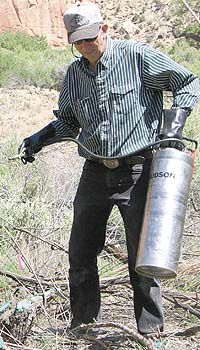| James Nielsen, heads the Emery County Weed and Mosquito department. He sprays herbicide on the tamarisk stumps. |
So why the assault on the seemingly innocent looking tamarisk? Well, according to Emery County Weed and Mosquito, main man, James Nielsen, the tamarisk is far from innocent. It is guilty of sucking gallons of water from the ground and wasting it.
Nielsen said, “We are trying three herbicides today to see which works the best on the tamarisk stumps. We are experimenting to find which herbicide we will use next year when the tamarisk reduction project takes place. The tamarisk is a non-native species which uses considerable amounts of water. They cause significant damage to surrounding vegetation by using all the water and choking out the native vegetation. They are spread rapidly by their seed. The seeds disperse and move all over. Those here in the Buckhorn are believed to have come from along the Colorado River.”
“The tamarisk is really strong wood and many ranchers make fence line stays out of it. Some of what’s cut out here might be used for that purpose. Some will be left to burn by campers and some will be chipped and left in place.
“We will check the stumps periodically through the summer and next spring to see if they are dead. During the project my department will be here treating the stumps and Carbon County is also working with us on this project. We are flagging the area with different color flags so we know which chemical was used in which area. We have also been working with biological control of the tamarisk and we have had good luck with that. The beetles have worked at removing foilage from the branches. Once the foilage is removed that kills the tamarisk. The tamarisk isn’t listed on the noxious weed list so we have had very few resources in dealing with them. This scout project will be a big help. You just can’t get the kind of manpower expected to be here next June. We are excited about this project.
“We are really having good luck with the insects eating the foilage. It usually takes years to see results, but we are seeing results of defoliation in just two-three years. We have just worked on the tamarisk as we have had time. The tamarisk has been a weed of concern for a long time. They have been invasive and crowded out the native specie. In some places if the water is available the tamarisk can take in 200 gallons of water and release it into the air each day.
“In some places when tamarisk is removed, then springs will reappear; the tamarisk pulls the water out before it even reaches the surface. For that reason tamarisk removal has come to the forefront. Water is a precious commodity. Our problem is we just haven’t had the manpower to deal with the tamarisk. We are just tickled to death to have the scouts come out and do this project. We have three full time people who will be working with the scouts the entire time they are here. This use of free manpower (scout power) will benefit the whole county.
“We are doing this experiment with the chemicals to see which works the best. If the Buckhorn Wash project is completed then the scouts can move to the area around Buckhorn Reservoir and other places with ponds that have tamarisk growing around them. But, the Buckhorn Draw area will be completed first and we’ll go from there.
“After the tamarisk is removed, then the native vegetation will come back along the river. The willows, grease woods, sage brush and rabbit brush will have a chance to re-establish. The grasses will also come back, the chemical we use on the stumps will not kill the grasses.
“The roots of the tamarisk run deep and bring up the salt in the soil which surrounds the tamarisk. This changes the chemical makeup of the soil and it’s hard for plants to re-establish themselves in the soil where tamarisk has been because of the salt content of the soil. Tamarisk changes soil conditions to favor itself. It was first brought here for ornamental purposes and some people thought it would be good to control erosion. We have found this isn’t true and where tamarisk stands are found there are steep banks where sloping banks used to exist. The tamarisk doesn’t hold the sand in place. The tamarisk changes the whole habitat surrounding a stream the way it affects the water flow,” said Nielsen.
Emery County will receive a boost from the Order of the Arrow scouts and their efforts will go a long way to thwart the tamarisk problem in the area. Each day the scouts work will set the tamarisk back 50 years in their threat to invade the county.

